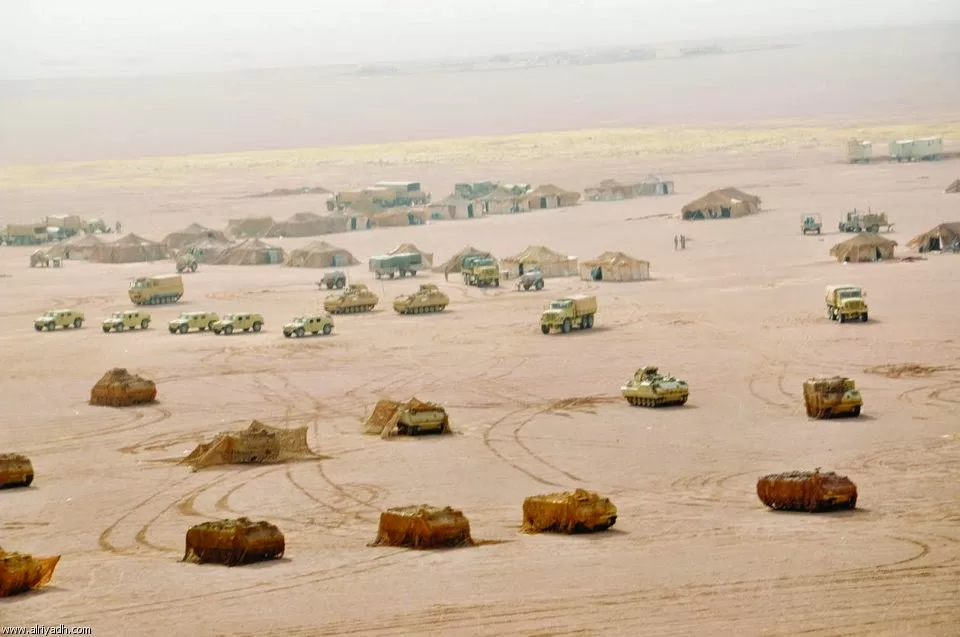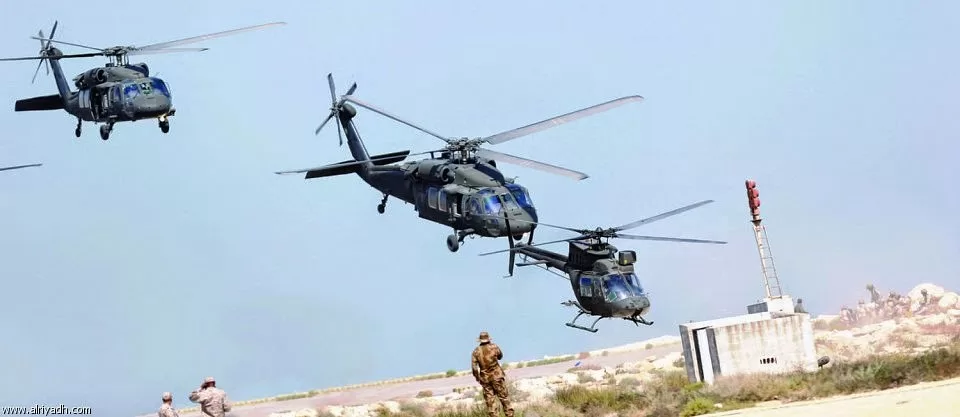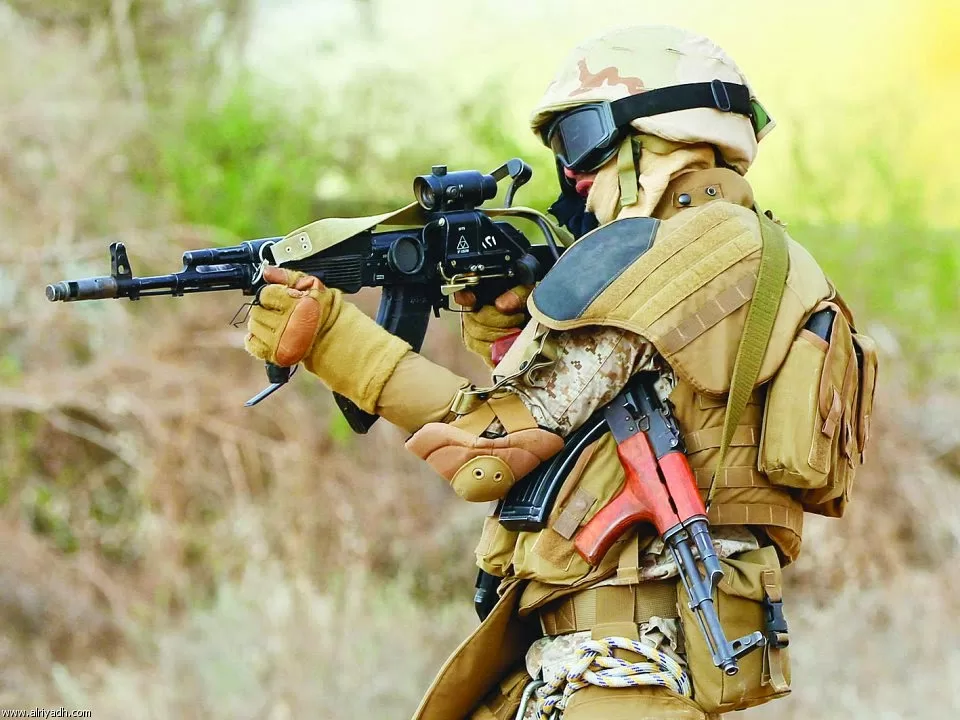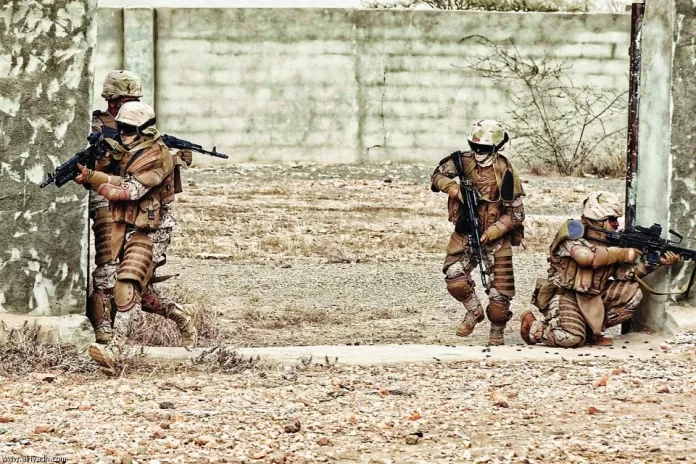Recently the Saudi Arabian Armed Forces conducted the largest military exercises in the Kingdom’s history, codenamed “Sword of Abdullah”. It was staged in a complete war theater of diversified but interrelated operations to strengthen the “combat capability of the Saudi armed forces’ in both offensive and defensive roles. Electronic Warfare (EW) units were also used extensively.
King Abdullah’s Orders
Crown Prince Salman, deputy premier and minister of defense was present at the event entitled “Saif Abdullah” or Sword of Abdullah in Hafr Al-Batin located in the northeast of the country. The exercise was carried out under the directives of the custodian of the two Holy Mosques, King Abdullah, supreme commander of the armed forces. The organizers commended King Abdullah for his efforts to strengthen the armed forces by providing soldiers with weapons, housing and healthcare.
By successfully conducting the largest military exercises Saudi Arabia has timely and clearly warned all its ill wishers beyond the region and potential enemies within the region that it is ready to defend its territory if attacked. It was also symbolically conveyed that the kingdom and its army are ready and capable to respond to any national security threat in light of the challenges, instability and unrest in the surrounding countries. By conducting military exercises on such a scale even the Gulf Cooperation Council (GCC) Common Security Shield again became relevant and dynamic.
Sword of Abdullah’s Details
It was held between April 16- 27 2014 in the southern, northern and eastern regions at the same time. In addition to the participation of units of the Saudi Arabia Ministry of National Guard, and members of the Ministry of the Interior in Eastern, Southern and Northern Regions rigorously participated in this largest ever military exercise aiming to raise the level of training and test the readiness of Saudi armed forces to deter any aggression launched towards any of these directions.
Geographic Significance
Geographically Hafr al Batin is a convergence point in the three countries and is also a natural route to both Kuwait and Iraq. The area is some 90 km from Kuwait and 70 km from Iraq. The Gulf waterway is also nearby so the selection of the playground for holding the said military exercises was superb and ideal.
Various units of ground, air, and naval forces, air defense forces, and strategic missiles force as well as units of the National Guard and members of the Ministry of Interior also participated. According to an official report more than 130,000 troops were involved in these exercises that also showcased its missiles capabilities. Tens of thousands of soldiers backed by military jets, helicopters and ships as well as tankers and anti-missile systems took active part. Boeing-supplied F 15 Eagle and AWACS aircraft as well as Apache helicopters, Aerospace’s Tornado aircraft, Raytheon’s missile and air defense systems and a host of formidable equipment were showcased.
Strong Domestic Industry
The visionary leadership of Saudi Arabia has made its militarily among the best equipped in the world, building, maintaining and continuously upgrading a leading edge in the region. The Kingdom of Saudi Arabia has wisely used its military acquisition programs to leverage investments as offsets to build its domestic industry from scratch. In this perspective, Saudi Arabia has particularly made impressive strides in oil, aerospace and defense technologies.
Cyber Warfare
Cyber warfare is the ideal combination of science and arts in which advanced knowledge of computer, aero-space and satellite plays very crucial role. Moreover, cyber warfare will play a decisive role in the future warfare theaters.
In today’s environment of fast-paced technological advancement, the threat of cyber-attacks cannot be downplayed as these could target banks, desalination plants and airports, especially since Saudi Arabia’s cyber infrastructure is still not so advanced and considered to be high risk (The cyber-attack on Aramco 2012). Keeping in view its diversity, utility and significance, the Saudi Armed Forces provided an opportunity to train the armed forces personnel on electronic warfare, which is no less dangerous than conventional threats. Saudi Arabia is now taking this kind of warfare quite seriously and according to official information the Saudi Defense Ministry is planning to establish an institute for electronic warfare. It will be based in the eastern region of the kingdom where important oil installations are located.

COAS General Raheel Sharif’s Participation
Pakistan’s Chief of Army Staff (COAS) General Raheel Sharif attended the Sword of Abdullah military exercises on an invitation by Crown Prince Salman bin Abdulaziz Al Saud. General Sharif expressed professional pride on the joint exercise and complimented it by saying: “the joint exercise reflected Saudi Arabia’s outstanding development and professionalism in the military field and proves the Saudi Government’s commitment and readiness”.
Gen Raheel Sharif was received at the Royal terminal by Deputy Defense Minister of Saudi Arabia Prince Salman Bin Sultan Al Saud and General Hussain bin Abdullah Al Qubayal, Chief of General Staff, Saudi Armed Forces. Services Chiefs of Saudi Armed Forces were also present at the reception as were dignitaries of other countries. The COAS witnessed the military exercise with the King of Bahrain, Crown Prince of United Arab Emirate, Prime Minister of Jordan and other military commanders from Gulf Cooperation Council countries.
Saudi’s General Chief of Staff
The General Chief of Staff, Lieutenant General Hussain Al Qabeel said, “We are preparing our armed forces to protect the nation”. The armed forces do not aim to attack anyone as this is not our wise government’s policy,” Al Qabeel added.
9th Anniversary of King Abdullah Accession to the Throne
The exercises coincided with the ninth anniversary of King Abdullah’s accession to the throne, while there was also a military parade which attracted a number of dignitaries from around the Arab world. For the first time ever, Saudi Arabia openly exhibited two of its several dozen missiles capabilities Feng-3 (DF-3) and multiple warhead (50-100kT) nuclear missiles, received in 1987.
Strengthening of Fighting Capabilities
“Saif-e-Abdullah” or Sword of Abdullah was conducted with utmost professionalism by the Saudi Armed Forces in the outskirts of Hafr Al-Batin, a historical city located in North Eastern Saudi Arabia. Tens of thousands of Saudi soldiers, backed by military jets, helicopters, light and heavy armoured vehicles loaded with anti-missile systems, participated in the maneuvers aimed at strengthening the Saudi armed forces’ fighting capabilities.
Saudi Crown Prince
Many high officials of the Kingdom of Saudi Arabian government and armed forces along with the Saudi Crown Prince witnessed the different sessions of military exercises with great interest. He also watched with great enthusiasm the combined exercise of Helicopters of ground, air, naval forces, the Royal Saudi Air Force show, the Green Falcons combat exercises, and the Paratroopers exercise of special ground and naval forces. The Saudi Crown Prince considered it a “landmark event in the Saudi, Gulf and Arabian military history”.
Prominent Dignitaries
Pakistan’s COAS General Raheel Sharif, King Hamad Bin Issa Al-Khalifa of Bahrain, Sheikh Mohammed Bin Zayed Al-Nahyan, Crown Prince of Abu Dhabi and Deputy Commander of UAE armed forces, and Sheikh Khalid Al-Jarrah Al-Sabah, Kuwaiti Deputy Premier and Defence Minister, and secretary-general of the defense ministry in Oman witnessed and lauded the strategic historical event.

Sheikh Mohammed Bin Zayed Al-Nahyan (UAE)
Sheikh Mohammed Bin Zayed Al-Nahyan praised Saudi Armed Forces’ efficiency in dealing with weapons and advanced military equipment. He said that Armed Forces’ preparedness and competency is a cornerstone in GCC joint defence.
Sheikh Khalid Al-Jarrah Al-Sabah (Deputy Prime Minister and Defence Minister, Kuwait)
According to Sheikh Khalid Al-Jarrah Al-Sabah, the grand exercise clearly reflected the advanced and superior capabilities achieved by the Saudi Armed Forces.
King Hamad Bin Issa Al-Khalifa (Bahrain)
King Hamad Bin Issa Al-Khalifa added that “conducting such a magnificent military drill reflects Saudi Arabia’s keenness on upgrading its Armed Forces’ combat competency”.
GCC Secretary General Dr. Abdullatif bin Rashid Al Zayani
GCC Secretary General Dr. Abdullatif bin Rashid Al Zayani extended sincere congratulations to the Custodian of Two Holy Mosques King Abdullah Bin Abdulaziz Al Saud, Prince Salman bin Abdulaziz Al-Saud, Crown Prince, Deputy Prime Minister and Defence Minister of the Kingdom of Saudi Arabia, on the occasion of the success of the joint exercise (Sword of Abdullah) executed by Saudi military units, considering it a landmark event in the Saudi, Gulf and Arabian Military history.
He expressed pride in this joint exercise, in which all units of the Saudi Armed Forces and other military sectors took part, noting that the joint exercise reflected Saudi Arabia’s outstanding development in the military field, and showed the advanced capabilities achieved by the Saudi Armed Forces in the areas of planning, management and training.
He added that conducting such a big military drill reflects Saudi Arabia’s keenness on upgrading its Armed Forces’ combat competency and the qualified cadres according to a strategic plan so as to face security threats.
Multiplier Effects
Military jets, helicopters, ships, tankers, anti-missile systems and other heavy equipment along with the different units/regiments of the armed forces took part in the Sword of Abdullah military exercises aimed at strengthening their operational, tactical and strategic fighting proficiencies. It would also raise the training level of its forces and testing their preparedness to deter enemy attacks. Prince Salman and other participants witnessed the military exercises on three platforms under different geographical and climatic conditions. The exercises were controlled from Riyadh.
Vehicles not associated with the DF-3 IRBMs but rather with Saudi Arabia’s upgraded nuclear deterrent force of the far more accurate single-warhead DF-21 MRBMs were also participated in the military parade.
Modern Weaponry
The largest military parade represented the success of the Saudi Armed Forces in developing its weaponry programmes and the superior combat capabilities of the Saudi Armed Forces. It also showed its high efficiency in dealing with weapons and advanced military equipment. It included various defence and attack operations, in addition to air and sea landing, as well as electronic warfare and air defence operations.
Reflection of Professionalism
It showed the Saudi armed forces personnel’s outstanding performance, readiness, high morale and professionalism in using all weapons and modern military technologies. It mobilized and improved tactical system and upgraded competence and military skills. It enhanced personal competence of its personnel and provided them with the latest and most developed military systems. It also demonstrated its professional readiness to safeguard the country and play a crucial role in the region’s stability too.

Strategic Maneuvering
Iran’s nuclear program, its alliance with Iraq and Syria and its off-shoots in Yemen (the tail of Saudi Arabia), Lebanon, Jordan and many scattered parts in the Middle East and North Africa (MENA) ultimately forced the Kingdom of Saudi Arabia to hold show of power indicating its own full preparedness, modern weaponry, martial professionalism of its armed forces and GCC allies and the last but not the least, strategic reach-out to face the challenge of Iran even after its friendly ties with the US and EU.
Amid the Arabian Gulf’s prevailing diplomatic atmosphere and rapidly changing geo-political and geo-strategic chess-board dominated by serious maneuverings and manipulations concern that ongoing international negotiations between the US/EU and Iran will leave Iran as a potential nuclear weapon state in the region, missile display signals Saudi Arabia’s determination to counter Tehran’s growing strength, as well as its readiness to act independently of the old ally, US.
Unmanned Combat Aerial Vehicles (UCAVs)
According to the Saudi Interior Ministry the unmanned combat aerial vehicles (UCAVs) of type Predator were also successfully tested during the exercises. These would definitely enhance the Kingdom’s operational, tactical and strategic preparedness in the longer period of time as well as further strengthen its surveillance system and give new meaning to its purposeful fight against terrorism. Saudi Arabia also signed a contract worth US$10 billion with General Dynamics to buy an undeclared number of armored vehicles.
The UAV is an aircraft with no pilot on board and it can be used as a remote controlled aircraft (e.g. flown by a pilot at a ground control station) or can fly autonomously based on pre-programmed flight plans or more complex dynamic automation systems. UAVs are currently used for a number of missions, including reconnaissance and attack roles.
The military role of UAV is growing at unprecedented rates. In 2005, tactical and theater level unmanned aircraft (UA) alone, had flown over 100,000 flight hours in support of Operation ENDURING FREEDOM (OEF) and Operation IRAQI FREEDOM (OIF). Rapid advances in technology are enabling more and more capability to be placed on smaller airframes which is spurring a large increase in the number of SUAS being deployed on the battlefield. The use of SUAS in combat is so new that no formal DoD wide reporting procedures have been established to track SUAS flight hours. It is hoped the successful testing of UCAVs during the just concluded largest military exercises would be value-addition to its armed forces in the days to come.
Concluding Remarks
Sword of Abdullah is aimed at sharing mutual exchange of experience and information through a comprehensive training programme in real time among the different security organs of the Saudi Arabia Armed Forces. It was also aimed at enhancing the capability of its armed forces to handle even traditional and non-traditional security threats. Different group of soldiers demonstrated a high sense of professionalism and determination during military exercise. The high morale of the participating troops would further boost the existing professional preparedness.
It prepared the Saudi Arabia Armed Forces to tackle all kinds of state and non-state threats in a real time. It provided them an opportunity to sharpen their professional skills and learn something new. It encouraged them to achieve new levels of preparedness to cope with the looming threat of terror.





